Article & Poster : Drop Medusa
Milton van Dyke Award at APS/DFD (Washington, DC, 2023)
D. Panda, L. Kahouadji, L. Tuckerman, S. Shin, J. Chergui, D. Juric, and O. Matar. Poster: Drop Medusa Gallery of Fluid Motion. 76th Annual Meeting of the APS Division of Fluid Dynamics, Nov. 2023. DOI:10.1103/APS.DFD.2023.GFM.P0030 - HAL:hal-04401557
D. Panda, L. Kahouadji, L.S. Tuckerman, S. Shin, J. Chergui, D. Juric & O.K. Matar. Axisymmetric and azimuthal waves on a vibrated sessile drop. Physical Review Fluids, 8(11):110510, Nov. 2023. DOI:10.1103/APS.DFD.2022.GFM.P0027 - HAL:hal-04292947
- PDF version of the article (from HAL)
- HTML version of the article (from APS)
- PNG version of the poster (from HAL)
- HTML version of the poster (from APS)
Context
Aerosol droplets, arising from the bursting of bubbles and drops at a liquid-gas interface, hold a crucial position at the confluence of diverse natural phenomena, industrial applications, and daily activities. Consider, for instance, the effervescence in sparkling drinks like champagne, where the bubbles that nucleate at the glass walls and eventually burst at the surface release the aromas experienced by the human senses. In atmospheric physics, marine aerosol plays a pivotal role in governing the overall mass and heat exchange process between the oceans and the atmosphere. This stems from the enormous quantity and rate of formation of liberated liquid drops formed across the oceans and capable of transporting an array of often surface-active substances, including salts, dissolved gases, biological material (e.g., harmful pathogens), microplastics, and toxic chemicals. Spanning a broad size range, from a few nanometers to several millimetres, marine aerosol actively participates in atmospheric chemical reactions, acts as nuclei for cloud and fog condensation, and can influence cyclone intensity. The aforementioned significance of aerosol droplets generated via bursting has made the system a notable problem within the realm of fluid mechanics.
Contribution
High amplitude radial acceleration of a fluid droplet in zero gravity at a frequency of 1040 Hz drives chaotic waves on the surface of the drop. The complex superposition of waves leads to craters of negative curvature that create localized jets resembling the hair of the Greek goddess, Medusa. One can observe analogies to numerous classical fluid dynamical configurations: Rayleigh capillary pinch-off, Worthington jet formation and breakup.
Impact
The American Physical Society’s annual Division of Fluid Dynamics conference is one of the premier worldwide gatherings encompassing all areas of fluid dynamics. It is also the forum for the Gallery of Fluid Motion where the science and beauty of fluid motion is visually showcased as inspired by Milton van Dyke’s book An Album of Fluid Motion. Contributions to the Gallery of Fluid Motion are also showcased in the National Academy of Science's cultural programs and traveling exhibitions. Our image entitled 'Drop Medusa' was selected in 2023 for the top prize, the Milton van Dyke Award.
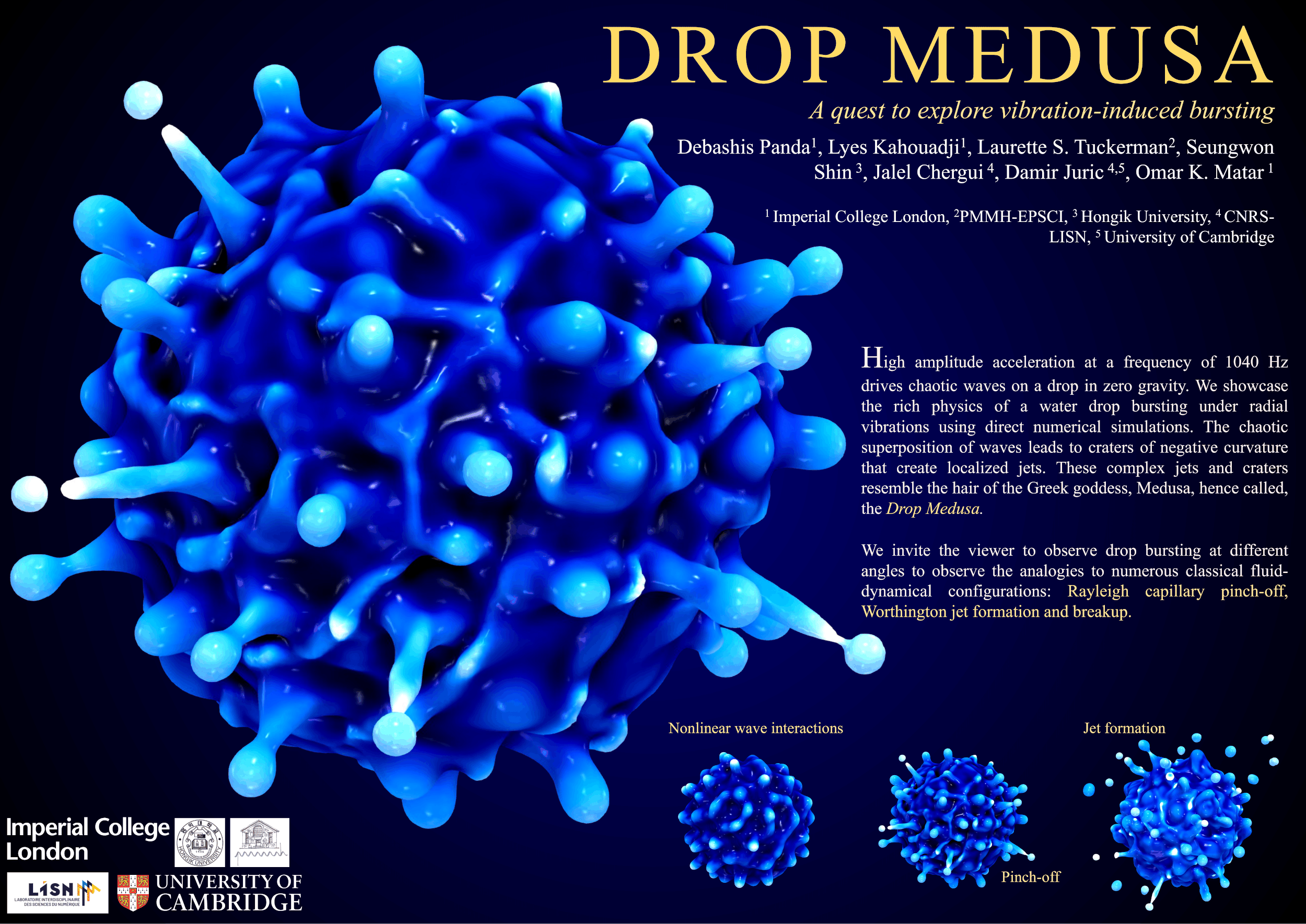
Article & Lamination: Magnetic field lines produced by a numerical von Kármán Sodium flow.
Lamination of the Jean Zay supercomputer dedicated to Artificial Intelligence (January 2019) magnetic field lines produced by a numerical von Kármán Sodium flow.
C. Nore, D. Castanon Quiroz, L. Cappanera & J. L. Guermond, Numerical simulation of the Von-Kármán-Sodium dynamo experiment. Journal of Fluid Mechanics, 854, pp. 164–195 (2018). DOI:10.1017/jfm.2018.582 - HAL:01575765
- PDF version of the article (from HAL)
- HTML version of the article (from Cambridge Core)
- HTML version of the poster (from IDRIS)
Context
The figure below shows the magnetic field lines produced numerically by integrating the Magnetohydrodynamics (MHD) equations in the configuration of the von Kármán Sodium (VKS) experiment. It comes from the article published in the Journal of Fluid Mechanics (Nore et al., 2018) which is the result of about 15 years of development of the SFEMaNS code, for Spectral/Finite Element code for Maxwell and Navier-Stokes equations, see website:
https://people.tamu.edu/~guermond//SFEMaNS/html/about.html
The obtained magnetic field reproduces the topology of the experimentally generated one in 2007 in the famous VKS experiment built at CEA Cadarache: 150 liters of liquid sodium are set in turbulent motion by two counter-rotating impellers located at the two extremities of a cylindrical container (Monchaux et al., 2007). Only three experimental setups in the world have been able so far to create a magnetic field from different turbulent flows of liquid sodium through a mechanism called the dynamo effect. There are many anti-dynamo theorems excluding the generation of magnetic fields for fluid flows that are too simple or too symmetrical. No one knows the unfailing recipe for creating magnetic fields from the turbulent motion of a liquid metal or a plasma (mechanism at work in the liquid core of the Earth or in the Sun).
In VKS, the dynamo effect appeared when the impellers, initially made of steel, were changed with impellers made of soft iron. Nobody understood then why the experiment worked. Our team has contributed to finding a credible answer to this puzzle.
Contribution
Our contribution has been to reproduce numerically the VKS experiment. This experiment presents two numerical challenges: first, the Reynolds number, Re=2 pi f R^2/nu, based on the impeller rotation frequency f, the cylinder radius R, and the fluid viscosity nu, exceeds 10^6! Even with today's supercomputers, it is necessary to use a turbulence model adapted to a configuration with walls to reach such high Re. Second, it is necessary to describe numerically the soft iron impellers, which exhibit variations in magnetic permeability.
Using Large-Eddy-Simulation (LES) turbulence modeling based on entropy stabilization concepts and a penalty technique for the impellers, we have performed MHD simulations on various supercomputers (up to 2048 cores on the IDRIS ADA computer) totaling 10^6 hours of computation. The ferromagnetic impellers of the 2007 Cadarache experiment are represented using a pseudo-penalty method. Simulations with high kinetic Reynolds number (10^5) are conducted using a new method of Large Eddy Simulations (LES). The results are in very good accordance with the experiments. The magnetic field is dominated by an axisymmetric axial dipole and azimuthal components located near the impellers in total agreement with the experimental data.
The MHD simulations show the key role played by the ferromagnetic material (with high magnetic permeability) constituting the impellers: increasing the magnetic permeability of the impellers lowers the dynamo threshold, which explains why this effect was achieved when the experimentalists replaced the steel impellers with the same soft-iron-made impellers.
Impact
The reproduction of the experimental velocity and magnetic fields in the VKS experiment is a real achievement since the flow is highly turbulent and the impellers are made of iron that are difficult to model. No other team has been able to conduct such massive numerical computations so far. This has opened the way to study in greater detail the transfers between kinetic and magnetic energies and to identify the terms responsible for the dynamo effect (Creff et al., 2024).
The magnetic field lines are represented in the figure below, which was selected to decorate the new supercomputer acquired by the Ministery de l'Enseignement supérieur, de la Recherche et de l'Innovation through GENCI from Hewlett-Packard Entreprise in January 2019.
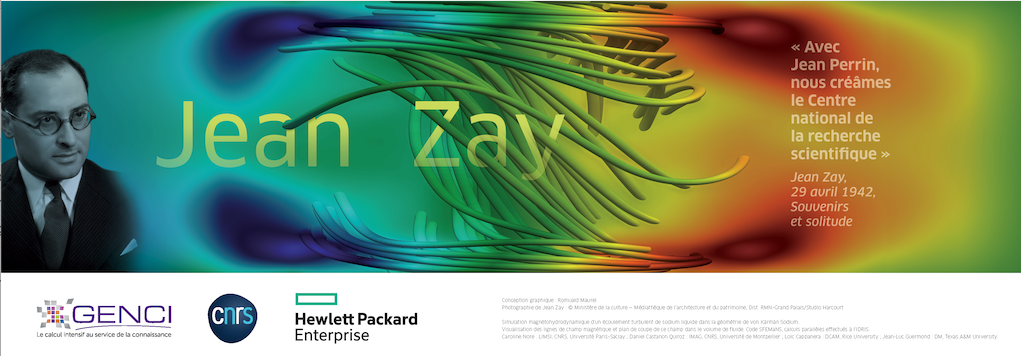
References
C. Nore, D. Castanon Quiroz, L. Cappanera , J. L. Guermond, Numerical simulation of the Von-Kármán-Sodium dynamo experiment. Journal of Fluid Mechanics, 854, pp. 164–195 (2018).
R. Monchaux, M. Berhanu, M. Bourgoin, M. Moulin, Ph. Odier, J.-F. Pinton, R. Volk, S. Fauve, N. Mordant, F. Pétrélis, A. Chiffaudel, F. Daviaud, B. Dubrulle, C. Gasquet, L. Marié, and F. Ravelet, Phys. Rev. Lett. 98, 044502 – Published 25 January 2007.
M. Creff, H. Faller, B. Dubrulle, J.-L. Guermond, C. Nore; Tracking dynamo mechanisms from local energy transfers: Application to the von Kármán sodium dynamo. Phys. Plasmas 1 February 2024; 31 (2): 022306. https://doi.org/10.1063/5.0174251
Article: Simple computational strategies for more effective physics-informed neural networks modeling of turbulent natural convection
D. Lucor, A. Agrawal & A. Sergent, Simple computational strategies for more effective physics-informed neural networks modeling of turbulent natural convection. Journal of Computational Physics 456 (2022) 111022. DOI:10.1016/j.jcp.2022.111022 - HAL:hal-03847907
Context
The high expressivity and agility of physics-informed neural networks (PINNs) make them promising candidates for full fluid flow PDE modeling. An important question is whether this new paradigm, exempt from the traditional notion of discretization of the underlying operators very much connected to the flow scales resolution, is capable of sustaining high levels of turbulence. Another concern is whether it can be used as a numerical substitute to full DNS data retrieval and storage; DNS remains so far the standard tool for validation and inter-comparison with experimental results.
Contribution
We explore the use of PINNs surrogate modeling for turbulent natural convection flows, mainly relying on DNS temperature data from the fluid bulk and velocity data at some fluid boundaries. This technique depends on the minimization of a composite loss function relying on labels and PDE residuals. We demonstrate the large computational requirements under which PINNs are capable of accurately recovering the flow hidden quantities. We then propose new techniques to mitigate the need for large training datasets. First, we propose a padding technique to better distribute some of the scattered coordinates at which PDE residuals are minimized, in particular in zones where no labels are available. We show how it comes into play as a regularization close to the training boundaries and results in a noticeable global accuracy improvement at iso-budget. We then propose a relaxation of the incompressibility condition involved in the loss function contribution related to the PDE residuals. This development drastically benefits the optimization search and results in a much-improved convergence.
Impact
The results obtained for Rayleigh-Bénard flow at Ra = 2E9 are particularly impressive. With training data amounting to only 0.32% of the stored DNS dataset, the predictive accuracy of the surrogate over the entire half a billion DNS coordinates yields errors for all flow variables ranging between [ 0.3% − 4% ] in the relative L 2 norm. This work was the first step towards the ANR project THERMAL (2023-26, with Physics Lab, ENS Lyon).
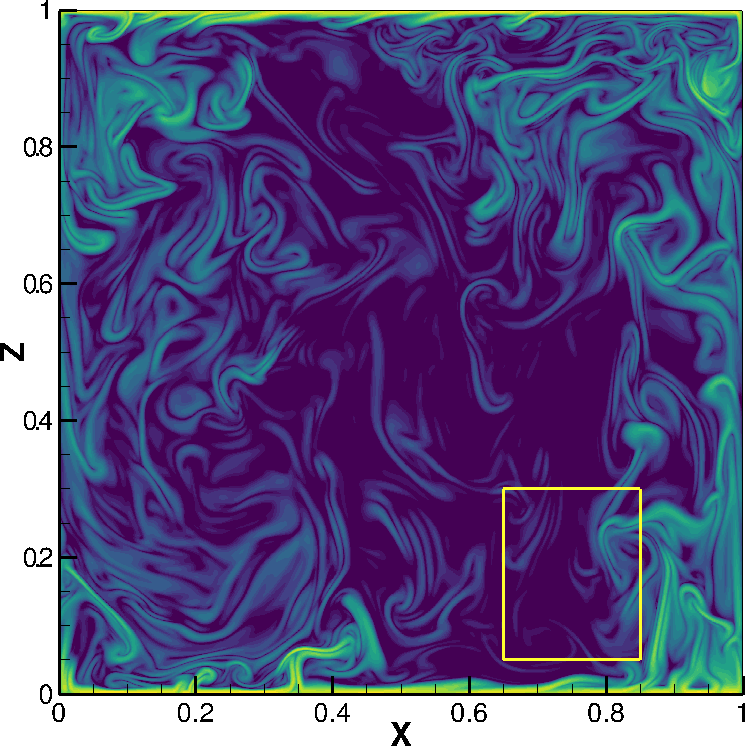
Article: Suppression of the Kapitza instability in confined falling liquid films
G. Lavalle, L. Yiqin, S. Mergui, N. Grenier, G. Dietze, Suppression of the Kapitza instability in confined falling liquid films. Journal of Fluid Mechanics, 860, 608-639 (2019). DOI:10.1017/jfm.2018.902 - HAL:hal-03322234
Context
This article is issued from the WavyFILM ANR project in collaboration between FAST, LIMSI/LISN and Air Liquide around wavy films. In the industrial domain of gas processing, cryogenic distillation is the main way to separate different components of air but is also very energy-intensive. A possible route to raise efficiency of the process is to enhance mixing occuring in the distillation columns in which a liquid film flows down on corrugated surfaces and is subject to a counter-current gas flow. Mass transfer between phases is enhanced by increasing gas mass flow but trigger possible flooding of the narrow gap in channels. The objective of this WavyFILM project is to study and improve mass transfer occuring in liquid films surrounded by a gas flow, by understanding mechanisms of instabilities by means of experiments, models and numerical simulations.
Contribution
In this first article published during the project, reduced modelling of the film in a confined channel with a counter-current gas flow and experiments with water film have been used to investigate the aforementionned problem. We have shown that the Kapitza instability at the origin of surface waves is suppressed when the channel is more confined (confinement η (ratio of channel height to film height) decreases, see figure [10(a)]) or when the counter-current gas is increased (measured with the gas Reynolds number Re g, see figure [14(a)]) :
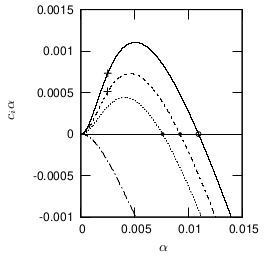
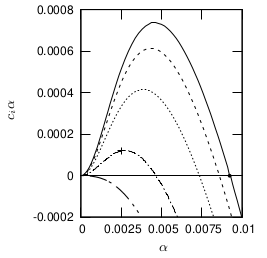
These numerical predictions have been confirmed by our experiments with water, which are quite difficult to conduct to measure instability growth rates in these conditions.
Impact
While this instability suppression was known for turbulent gas flow regime in large channels, this study exhibits this phenomenon for the first time for low gas Reynolds numbers or highly confined channels. This article have been cited 19 times since publication on 2018 (excluding our group citations; source: Google Scholar on 16/05/2023).
After this first step in the linear regime, this work have been extend to solitary waves solitary waves [1] as well as non-linear regime [2], with experimental investigations [3].
References
[1] Solitary waves on superconfined falling liquid films, G Lavalle, N Grenier, S Mergui, GF Dietze - Physical Review Fluids, 2020. URL
[2] Superconfined falling liquid films: linear versus nonlinear dynamics, G Lavalle, S Mergui, N Grenier… - Journal of Fluid Mechanics, 2021. URL
[3] Nonlinear wave attenuation in strongly confined falling liquid films sheared by a laminar counter-current gas flow, S Mergui, G Lavalle, Y Li, N Grenier… - Journal of Fluid Mechanics, 2023. URL